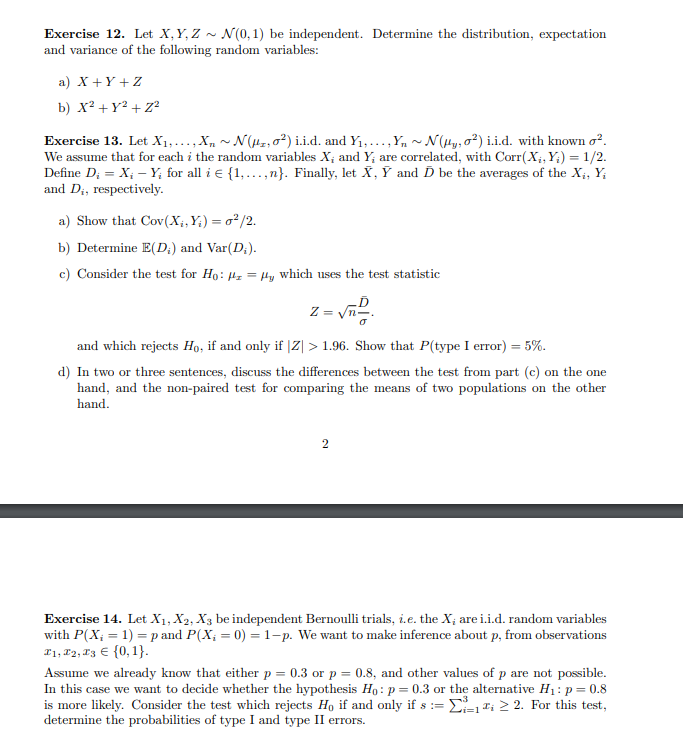Exercise 13. Let X₁, X₂₁~ N(H₂,o2) i.i.d. and Y₁,...,Y~N(₂, ²) i.i.d. with known o². We assume that for each i the random variables X, and Y; are correlated, with Corr(X₁, Yi) = 1/2. Define D; = X₁ — Y; for all i € {1,...,n}. Finally, let X, Y and D be the averages of the X₁, Y₁ and D₁, respectively.
Exercise 13. Let X₁, X₂₁~ N(H₂,o2) i.i.d. and Y₁,...,Y~N(₂, ²) i.i.d. with known o². We assume that for each i the random variables X, and Y; are correlated, with Corr(X₁, Yi) = 1/2. Define D; = X₁ — Y; for all i € {1,...,n}. Finally, let X, Y and D be the averages of the X₁, Y₁ and D₁, respectively.
Algebra & Trigonometry with Analytic Geometry
13th Edition
ISBN:9781133382119
Author:Swokowski
Publisher:Swokowski
Chapter10: Sequences, Series, And Probability
Section10.8: Probability
Problem 32E
Related questions
Question
Exercise 13 pls

Transcribed Image Text:Exercise 12. Let X, Y, Z ~ N(0,1) be independent. Determine the distribution, expectation
and variance of the following random variables:
a) X+Y+Z
b) x² + y² + Z²
Exercise 13. Let X₁,..., X₁~ N(2,02) i.i.d. and Y₁,...,Y₁ ~ N(Hy, ²) i.i.d. with known o².
We assume that for each i the random variables X, and Y; are correlated, with Corr(X₁,Y)= 1/2.
Define D₂ = X₁ - Y; for all i € {1,...,n}. Finally, let X, Y and D be the averages of the X₁, Y;
and D₁, respectively.
a) Show that Cov(X₁,Y₁) = 0²/2.
b) Determine E(D;) and Var(D₂).
c) Consider the test for Ho: z = Hy which uses the test statistic
Z=
and which rejects Ho, if and only if |Z| > 1.96. Show that P(type I error) = 5%.
d) In two or three sentences, discuss the differences between the test from part (c) on the one
hand, and the non-paired test for comparing the means of two populations on the other
hand.
2
Exercise 14. Let X₁, X2, X3 be independent Bernoulli trials, i.e. the X, are i.i.d. random variables
with P(X; = 1) = p and P(X; = 0) = 1-p. We want to make inference about p, from observations
#1, #2, #3 € {0, 1}.
Assume we already know that either p = 0.3 or p = 0.8, and other values of p are not possible.
In this case we want to decide whether the hypothesis Ho: p = 0.3 or the alternative H₁: p = 0.8
is more likely. Consider the test which rejects Ho if and only if s = ₁1₁ ≥ 2. For this test,
determine the probabilities of type I and type II errors.
Expert Solution
This question has been solved!
Explore an expertly crafted, step-by-step solution for a thorough understanding of key concepts.
Step by step
Solved in 5 steps

Recommended textbooks for you

Algebra & Trigonometry with Analytic Geometry
Algebra
ISBN:
9781133382119
Author:
Swokowski
Publisher:
Cengage

Algebra & Trigonometry with Analytic Geometry
Algebra
ISBN:
9781133382119
Author:
Swokowski
Publisher:
Cengage